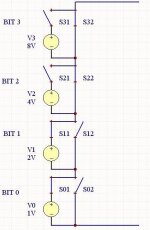well... i just got this totally ridiculous idea  . how about a power DAC? hear me out... say we have a digital parallel n-bit stream of unsigned audio. we'll discuss this for the positive part of the signal (we asume the signal to be n-bit POSITIVE) right... also suppose we have n independent voltage sources V where i=0..n-1 with the property that V=2xV[i-1].
. how about a power DAC? hear me out... say we have a digital parallel n-bit stream of unsigned audio. we'll discuss this for the positive part of the signal (we asume the signal to be n-bit POSITIVE) right... also suppose we have n independent voltage sources V where i=0..n-1 with the property that V=2xV[i-1].
for every voltage source we have 2 switches, that insert, or take out the voltage source from the circuit...
just take a look at the picture... it's a 4 bit d/a converter...
of course this basic design can be implemented in any way... the way i thought of it was with mosfets as the switches, driven by a microprocessor with highly oversampled signal.
just a crazy idea i thought i'd share with the rest of the world ... 🙂
 . how about a power DAC? hear me out... say we have a digital parallel n-bit stream of unsigned audio. we'll discuss this for the positive part of the signal (we asume the signal to be n-bit POSITIVE) right... also suppose we have n independent voltage sources V where i=0..n-1 with the property that V=2xV[i-1].
. how about a power DAC? hear me out... say we have a digital parallel n-bit stream of unsigned audio. we'll discuss this for the positive part of the signal (we asume the signal to be n-bit POSITIVE) right... also suppose we have n independent voltage sources V where i=0..n-1 with the property that V=2xV[i-1]. for every voltage source we have 2 switches, that insert, or take out the voltage source from the circuit...
just take a look at the picture... it's a 4 bit d/a converter...
of course this basic design can be implemented in any way... the way i thought of it was with mosfets as the switches, driven by a microprocessor with highly oversampled signal.
just a crazy idea i thought i'd share with the rest of the world ... 🙂
Attachments
Good idea! How would you make all the different voltages - multi-output switching converter? I'm sure you realize you need the negative side (voltages) also. I think you will end up with a lot of parts, but it would be a fun project. Build it and tell us how it turns out.
Actually, I have toyed around a bit with a similar idea, although
I was thinking of current switches instead (ie. binary controllable
CCSes). I suppose it might perhaps be possible for DIY purposes
to trim the CCSes relative to each other. However, I also suppose
it would be much harder to get good precision from a power DAC
than from a small-signal one, consider eg. that power devices are
slower and have longer rise and fall times. A compromise might
be to use fewer bits but oversampling, as in early CDPs. Another
possibility might be to have some self-calibration, or manual,
where the output errors for every pair of subsequent input values
is logged and a correction table is calculated and used to modify
the input (what would this be? Off-line feedforward correction???)
One
interesting potential feature is that it might be possible to have
the volume control set the DAC reference level, which would have
the benefit of not needing a better dynamic range than the source.
Please note, I have only toyed around with a loose idea, so I have
no good guess at how feasible such a project would be. Besides,
it is probably only of interest for people having digital sources only,
making it of less interest to me, for instance. It is a fun idea though.
I was thinking of current switches instead (ie. binary controllable
CCSes). I suppose it might perhaps be possible for DIY purposes
to trim the CCSes relative to each other. However, I also suppose
it would be much harder to get good precision from a power DAC
than from a small-signal one, consider eg. that power devices are
slower and have longer rise and fall times. A compromise might
be to use fewer bits but oversampling, as in early CDPs. Another
possibility might be to have some self-calibration, or manual,
where the output errors for every pair of subsequent input values
is logged and a correction table is calculated and used to modify
the input (what would this be? Off-line feedforward correction???)
One
interesting potential feature is that it might be possible to have
the volume control set the DAC reference level, which would have
the benefit of not needing a better dynamic range than the source.
Please note, I have only toyed around with a loose idea, so I have
no good guess at how feasible such a project would be. Besides,
it is probably only of interest for people having digital sources only,
making it of less interest to me, for instance. It is a fun idea though.
The multibit power DAC (with switched voltages) is a very nice idea in theory, but will be a nightmare to put in practice.
A controllable current-source will be easier to build but the load must be pure resistive (not suitable to drive directly a speaker)... 🙁
A controllable current-source will be easier to build but the load must be pure resistive (not suitable to drive directly a speaker)... 🙁
- Status
- Not open for further replies.
- Home
- Amplifiers
- Solid State
- totally ridiculous digital amplifier (power DAC) idea
